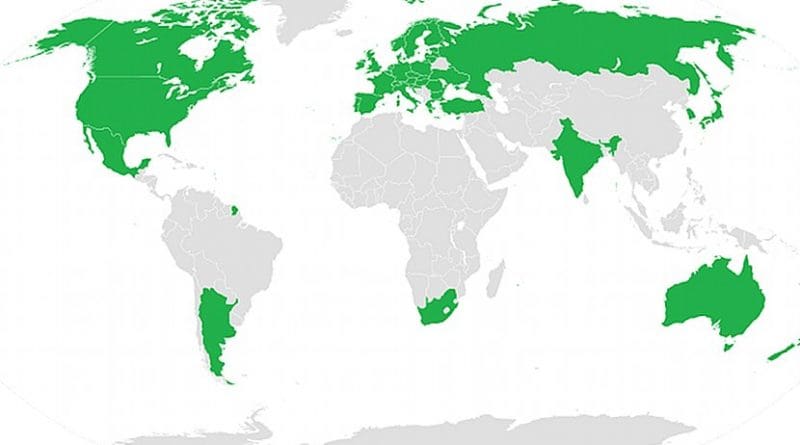India’s Admission Into The WA And Impact On New Delhi’s NSG Bid – OpEd
India, very recently received the happy news of gaining admission into another export control cartel. The Plenary meeting of the Wassenaar Arrangement (WA) held on 6 — 7 December 2017 in Vienna, Austria. The plenary decided to admit India formally into its group after which it will become the arrangement’s 42nd participating state. The necessary procedural arrangements for India’s admission will be completed by next year. Subsequently, India is now member of the two of four export control regimes, other being Missile Technology Control Regime (MTCR).
The Wassenaar Arrangement is one among the three other multilateral export control regimes that works on the concerns related to the export controls for conventional arms, dual-use goods and technologies. It was basically established to contribute to regional and international security and stability by promoting transparency along with greater responsibility in transfers of conventional arms, dual-use goods and technologies. This way it can prevent destabilizing accumulations in future. The member states, through their national policies seek to ensure that the transfer of these items do not contribute to the development or enhancement of military capabilities that have the probability to undermine the overall goals of the export control cartel. However, in case of India, it would be hard to anticipate if it would limit the use for civil purposes only.
V. Sudarshan narrates the cause of India’s ambition of joining Wassenar Arrangement, in his article titled Why is Wassenaar Arrangement important to India? He said that it is, to bring security and stability by fostering transparent practices in the process of transfer of arms, transfer of materials, and technologies that can be used to make nuclear weapons with a view to prevent any undesirable build-up of such capabilities. Whereas, in reality, if one examines Indian behavior after joining a similar kind of arrangement, called MTCR in 2016, India immediately decided to extend the range of its Brahmos supersonic cruise missiles beyond the current 300 km, which is a joint venture of India and Russia. The MTCR actually works to restrict the proliferation of missiles, complete rocket systems, unmanned air vehicles, and related technology for those systems capable of carrying a 500 kilogram payload at least 300 kilometres, as well as systems intended for the delivery of weapons of mass destruction (WMD). Initially the MTCR membership meant at aiming mutual benefits in the furtherance of international non-proliferation objectives. Sardonically, it proved to be incorrect owing to the Indian behavior after getting into the MTCR. Therefore, it can be deduced that even after joining the Wassenar Arrangement, India would not practice the security and stability of its dual-use items in a transparent manner especially when the traces of its illegal trafficking is on record. It would be pertinent to mention here that few of India’s reactors are still unsafeguarded that are kept out of transparency, deliberately, for aiding fuel to its military capabilities.
While granting India’s membership to the arrangement, Russia had expressed its optimism as Deputy Foreign Minister Sergey Ryabkov called it, an example and reflection of Russia’s unwavering support to India’s membership to international nuclear control regimes. Besides Russia, the US and France also played key roles in ensuring India’s membership to Wassenaar Arrangement. China on the other hand, has denounced the significance of India’s entry into the export control cartel i.e. Wassenaar Arrangement. Similarly on many forums, Chinese diplomats were vocal that it might not necessarily pave the way for New Delhi’s admission into the NSG as the elite nuclear group may have a different criterion.
Since India’s civil nuclear deal with the US, France and Russia, it has been continuously trying to get into the export control regimes such as the NSG, the MTCR, the Australia Group and the Wassenaar Arrangement. By entering into such cartels India can regulate the conventional, nuclear, biological and chemicals weapons and technologies. However, the trend of assistances to India, set-in largely by the US, though for its own interest, has and will further overwhelm India with uranium reserves. Since India’s nuclear program is largely plutonium based, its uranium reserves are apparently shown to be low for civil nuclear usage, and are actually low for military usage.
However, though India managed the membership of two export control regimes but it is not a criterion to be taken-up by the international community that India’s entry into the export control regime could enhance its credentials in the field of non-proliferation despite not being a signatory to the Non-Proliferation Treaty (NPT). Nor the membership could be expected to build-up any case for India’s entry into the Nuclear Suppliers Group which currently is stalled mainly due to China.


Don’t you get bored of whingeing on the same topic? that too devoid of logic and any semblance of intellectual honesty/rigor? for a country near constantly in the IMF ‘ICU ward’, the gall is amazing.
by your own logic then China should be kicked out of the NSG for proliferation of WGU to pak. and you should very well be knowing that China’s MTCR application is pending since 2004 owing to China selling missiles to pakistan.
India has partial NSG membership already and is a leader in ENR. The NSG membership would simply be ‘formalizing’ the recognition of India’s nuclear status justly negating the duplicitous standards imposed by the P-5 through the NPT.